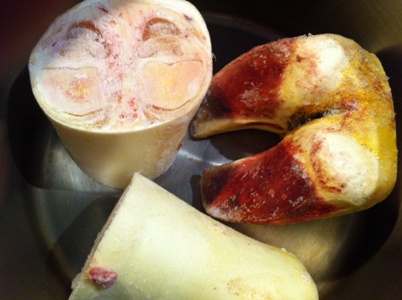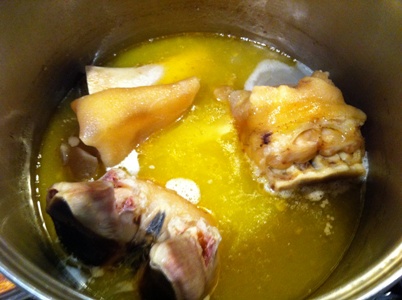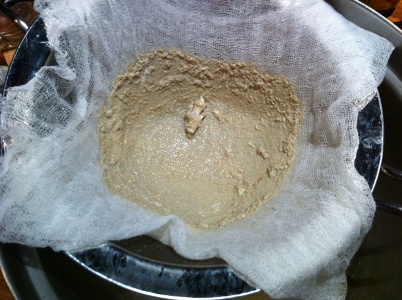Calf’s feet jelly
Ingredients
- 4 calves' feet (each cut into three or four pieces)
- 2 egg whites, whipped until frothy
- 2 eggshells (crushed)
Note
This is the foundation gelatin concentrate which is then flavoured and coloured to make jellies. Watch the video of 'the Cook' making this recipe in the kitchen at Vaucluse House.
Calves' feet can be difficult to find in conventional butchers shops, but can be purchased in suburbs that cater for Korean and Chinese communities, such as Campsie or Ashfield in Sydney. More than just the hoof, a calf's 'foot' can be up to 30 cm long, and as they are nearly all bone, ask the butcher to cut each one into three or four pieces so they'll fit into a domestic pot (albeit a large one!).
Making gelatine this traditional way is at least a two-day process.
Directions
|
Cooking the calves
|
|
|
 Place the calves' feet pieces into a lidded stockpot or large saucepan and add just enough water to cover. Cook, partially covered, on a medium heat to maintain a strong simmer for about 2 hours. |
|
Clarifying process
|
|
|
 Strain the extracted liquid through a sieve lined with muslin or clean kitchen cloth, discarding any solids. Refrigerate the liquid for several hours or overnight to allow any fat to rise to the surface.
Skim off as much of the oily layer as possible using a large metal spoon. You will be left with a dense jellied mass which then needs to be clarified. |
|
|
 Combine the beaten egg whites with the crushed eggshells and place the mixture in a medium sized saucepan with the calf’s foot extract over a low heat. Bring to a gentle simmer and cook for 10–15 minutes. As the liquid simmers the impurities are drawn into the egg white and eggshell mixture. |
|
|
 Skim the surface of the liquid carefully and strain the jelly through fine muslin, discarding any solids. Refrigerate until set. The jelly should be able to hold its form quite strongly; if it is still liquid, reduce by boiling it on the stove to the desired concentration. |
|
Making the jelly
|
|
|
 Melt the 'solid' jelly in a pan over low heat and strain again through a dampened linen tea towel or muslin, using a very fine strainer. The clear jelly is now ready to flavour for use in any recipe calling for jelly - usually this would be with some white wine, orange blossom water or lemon juice. The jelly would be coloured with natural food dyes such as spinach, beetroot juice or a saffron infusion. |
|
|
 |
Have you tried this recipe?
Use the comments box below to upload comments and photos.
 Print recipe
Print recipe




